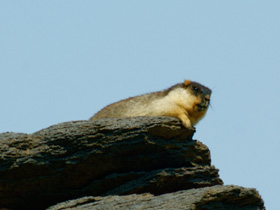The black-capped marmot (Marmota camtschatica)
Description and distribution
The black-capped marmot (Marmota camtschatica) is a species of marmot. It has three subspecies: North Baikal, Lena-Kolyma and Kamchatka. The North Baikal subspecies is biologically similar to the Mongolian marmot - tarbagan (Marmota camtschatica sibyrika).
This species of marmot is commonly found in Eastern and North-Western Siberia, in the Kharaulakh mountains, etc. It is also called Kamchatka marmot or Eastern marmot. The marmot gets its name because of its colouring: uniform brown all over the body with a dark spot on the head. From afar it looks as if it is wearing a black cap.
Lifestyle and burrows
Marmota camtschatica lives in separated families. Each family has its own burrow for wintering, as well as several summer burrows and about 14 temporary dens. Families usually settle on dry southern, low-snow slopes of mountains and hills at an altitude not exceeding 1.2 km above sea level. Burrows of Marmota camtschatica are not very deep. Burrows are located at a depth of about 20 to 70 centimetres. Burrows often have a complex system of labyrinths and exits. This is done specially to allow more heat to penetrate into the burrow in summer and to thaw and dry the frozen ground faster.
Facing work in Marmota camtschatica is also present. They coat the walls of their nesting chamber with a mixture of grass clippings and earth. In winter or cold autumn Marmota camtschatica like to plug their passages with plugs of dry grass.
Lifestyle of the Lena-Kolyma subspecies
The Lena-Kolyma subspecies Marmota camtschatica has acquired a number of adaptations for living in very harsh conditions. Each marmot settlement usually has one wintering burrow, up to 4-5 summer burrows and about 10 (up to 17) temporary (fat) burrows. Settlements are located on low-snow dry southern and south-western slopes of mountains and hills up to 4,200 m above sea level. The passages and chambers of wintering dens are laid at a shallow depth (from 22 to 70 spruce) in a frozen layer of ground, the temperature of which drops to -14, - 16°C in February-March and warms up to +1.5, +2°C by the end of summer.
The large length of passages (up to 113 m) and a large number of burrow exits (up to 18) contribute to better penetration of heat into the burrow in summer and thus accelerate thawing and drying of the ground. Near the passages the ground thaws 30-50 cm deeper than in the adjacent areas, from which marmots rake up the ground and drag stones over the passage and chamber, thus increasing the thickness of the hut ceilings by 11-32 fathoms. This elevation thaws earlier in spring. The walls of the nesting chamber of Marmota camtschatica are covered with a mixture of earth and grass clippings as a plaster, and in cold weather dry grass is used to make plugs in the passages connected with the nesting chamber. In the hibernation chamber, the weight of nest lining reaches 9-12.5 kg. Lena-Kolyma Marmota camtschatica go into hibernation from the second half of September - early October, when snow cover is already established and air temperature outside drops to -10, -20°C. All marmots of one settlement (up to 25-30 individuals) lie in one chamber. In addition to external earth plugs, they make several grass plugs close to the nesting chamber. Marmota camtschatica lie closely pressed together in one row, or if there are many of them, in two tiers. Awakening occurs in May, although snow does not melt until mid-June. Mating occurs in burrows in the second half of April, 3-4 weeks before emergence to the surface. One brood has an average of 5-6 (3 to 11) marmots. About 75% of sexually mature females take part in reproduction. According to these indicators, the fecundity of Lena-Kolyma Marmota camtschatica is higher than that of forms distributed further south.
Subspecies:
- Marmota camtschatica camtschatica camtschatica - Kamchatka;
- Marmota camtschatica bungei - Yakutian;
- Marmota camtschatica doppelmayri - North Baikal.

















































